

English Cobuild dictionary. To meet the needs of people learning English, Reverso offers a free English dictionary that goes far beyond what a normal monolingual dictionary or thesaurus can provide by explaining the use of words and phrases in natural language and providing real-life examples.
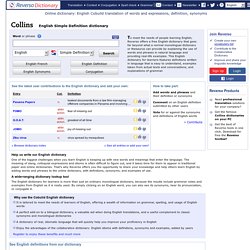
This English dictionary for learners features definitions written in language that is easy to understand, examples taken from actual texts and conversations, and explanations of grammar. See the latest user contributions to the English dictionary and add your own: Welcome to Five Acres. Richard lavoie. Learning Disabilities in English Language Learners.
Classroom Strategies. For Families with Struggling Readers. Finding books to read. Charles is a struggling reader.

Like three out of four children with reading difficulties, Charles is a boy. He started school with limited experience with print, struggled through activities with letters and sounds, and tended to be off task when there was independent reading time. He learned in second grade to have his reading buddy do most of the reading. By third grade, when most of his classmates were fairly fluent, Charles was still guessing at words, using picture clues and avoiding books whenever he could. In fourth grade, when the illustrations were gone, Charles was in obvious trouble. There are few tasks more challenging for teachers than reaching struggling middle school readers like Charles.
Like many struggling readers, Charles has problems that can be diagnosed. Increasing the quantity and quality of his reading. Parents. Parent's Guide to IDEA. Fighting for your Child's Rights. A Parent's Perspective — Tools for the High School Student with LD. Our daughter Hillary was in the fifth grade when she was originally diagnosed with a language disability.
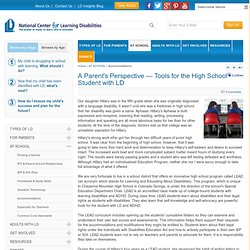
It wasn't until she was a freshman in high school that her disability was given a name: Aphasia. Hillary's Aphasia is both expressive and receptive, meaning that reading, writing, processing information and speaking are all more laborious tasks for her than for other students. At the time of the diagnosis, doctors told us that college was an unrealistic aspiration for Hillary. Hillary's strong work ethic got her through two difficult years of junior high school. What Every Teen with a Learning Disability Should Know. Most teenagers struggle with their self-image.
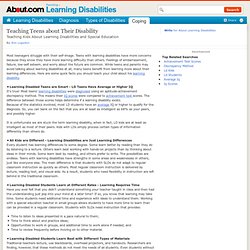
Teens with learning disabilities have more concerns because they know they have more learning difficulty than others. Feelings of embarrassment, failure, low-self esteem, and worry about the future are common. While teens and parents may avoid talking about learning disabilities at all, many teens benefit from learning more about their learning differences. Here are some quick facts you should teach your child about his learning disability. Learning Disabled Teens are Smart - LD Teens Have Average or Higher IQ It's true!
Because of the statistics involved, most LD students have an average IQ or higher to qualify for the diagnosis. It is unfortunate we are stuck the term learning disability, when in fact, LD kids are at least as intelligent as most of their peers. Communicating Your Needs in College. 10 tips for high school students with learning disabilities. Being Your Own Advocate. Having learning disabilities often means having special needs.
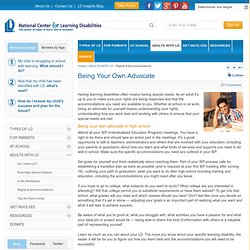
As an adult it's up to you to make sure your rights are being respected and that the accommodations you need are available to you. Whether at school or at work, being an advocate for yourself means understanding your rights, understanding how you work best and working with others to ensure that your special needs are met. Understanding My Learning Disability. Autism.
Sensory Motor Integration. Sensory motor integration refers to a relationship between the sensory system (nerves) and the motor system (muscles).
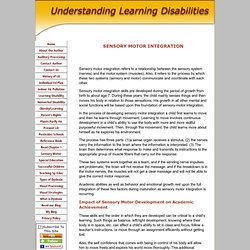
Also, it refers to the process by which these two systems (sensory and motor) communicate and coordinate with each other. Sensory motor integration skills are developed during the period of growth from birth to about age 7. During these years, the child mainly senses things and then moves his body in relation to those sensations. Visual Processing Disorder. For special education purposes, a visual processing disorder, or visual perceptual disorder refers to a child’s limited ability to make sense of information taken in through the eyes.

School vision screenings routinely check the ability to see clearly at a distance of 20 feet as measured by an eye chart. Unfortunately, this is all school vision screenings are designed to check, and a child's vision involves so much more. First of all, children must have crisp, sharp eyesight in order to see the print clearly. Visual Impairment. Listen The human eye is like a camera that collects, focuses, and transmits light through a lens to create an image of its surroundings.
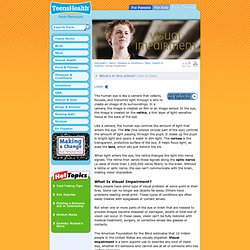
In a camera, the image is created on film or an image sensor. In the eye, the image is created on the retina, a thin layer of light-sensitive tissue at the back of the eye. Like a camera, the human eye controls the amount of light that enters the eye. The iris (the colored circular part of the eye) controls the amount of light passing through the pupil. When light enters the eye, the retina changes the light into nerve signals. What Is Visual Impairment? Auditory Processing Disorders.
By: National Center for Learning Disabilities (NCLD) Introduction.
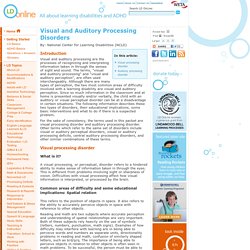
Auditory Processing Disorder the Learning Disability.